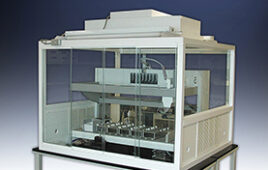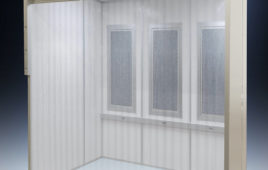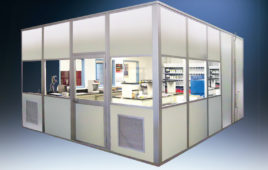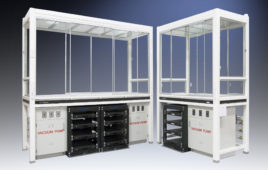Rigorous contamination control helps speed products to market.
There is a growing need for comprehensive, integrated strategies to ensure removal of potential virus contaminants in biopharmaceutical production. Filtration, purification, and separation technologies, as well as validation capabilities, help lower the cost of drug therapy development and accelerate time-to-market. The recommendations in this article will help companies achieve marketing approval and avoid compliance pitfalls after new drugs reach full-scale production by ensuring proper test sensitivity and reliability.
As the science of biotechnology progresses, companies need to consider a greater range of variables, from lab to production scale, to maximize opportunities for success. Compliance requirements for large-scale filtration in a production environment can be different from those encountered at the laboratory bench scale qualification level. Failure to apply proper integrity testing parameters for production virus filters can result in GMP non-compliance in the scale-up and manufacturing phases, which can lead to expensive cost overruns and lost productivity.
Viruses
Viruses are infectious disease-causing agents that reproduce only in living host cells and are transmissible in cell-free biological fluids, e.g. biopharmaceuticals. They are very small particles, 20-250 nm (0.02-0.25 µm), as small as 1/10 the size of the smallest bacteria. The general structure of a virus is a core with nucleic acid (RNA or DNA) within a protein “capsid” shell. Some viruses also feature an outer membrane layer or “envelope” that is host cell-derived and incorporates both host and viral-specific surface antigens. Sources of viral contamination may be donor-associated viruses from cell lines, plasma, or tissues. Other adventitious viruses can be introduced during production from culture media (serum), purified growth factors or other additives from biological sources, monoclonal antibodies used in downstream immunoaffinity purification processes, from environmental sources originating from the air or from operators, or from formulating agents of biological origin, e.g. albumin.
Regulatory Considerations
The regulatory position on viruses given in the FDA/International Congress for Harmonization (ICH) Harmonized Tripartite Guideline is that “Confidence that the infectious virus is absent from the final product will in many instances not be derived solely from direct testing for their presence, but also from demonstration that the purification regimen is capable of removing and/or inactivating the viruses.”1 Also, the European Committee on Proprietary Medicinal Products (CPMP) Notes for Guidance on Virus Validation Studies state, “…many instances of contamination in the past have occurred with agents whose presence was not known or even suspected at the time of manufacture.”2 In light of this regulatory guidance, considerations should include:
* Risk assessment based on potential for viral presence, load, and drug indication
* Incorporation of multiple viral clearance methods
* Validation of the viral log reduction factor of each process step
* Recognition that “orthogonal” methods (i.e. with different mechanisms) can be log additive
* Determination of the total process clearance factor
The overall strategy should include screening of source materials, employment of virus “barriers” such as air, vent, and liquid filtration or inactivation, incorporation of robust viral clearance in the purification process, and testing for viruses during production.
Virus Removal Filters
Prerequisites for virus removal filters include consistent, reproducible performance with respect to virus retention and product transmission at both bench and process scale. Integrity testing of process filter elements and assemblies should be correlated to virus removal, sensitive to detect potential membrane defects or damage, easy to perform in a production setting, and easy to automate.
Core Validation and QC
The filter manufacturer must develop core validation data for the virus removal membrane and process scale production filter elements. This data should include bacteriophage (viruses of bacteria) challenges of both membrane samples and filter elements. The tests should model representative challenge conditions with standardized test fluids, pressures, and throughputs. Integrity tests for production filter elements are conducted to establish test conditions and limits demonstrating sensitive correlation to viral clearance. Extractables from filter elements in model process fluids are quantified in terms of non-volatile residue and characterized using FTIR spectroscopy. Biological safety of filter element components should also be assessed by testing to USP limits under Biological Toxicity, in vivo, for Class VI-121° plastics.
Quality control of production filter elements should involve ongoing bacteriophage challenge testing of lot samples, along with 100% integrity testing of finished elements by the validated test method. The lot sample bacteriophage challenge confirms continuing validity of the integrity test correlation to viral removal efficiency. Additional QC lot sample testing should include steam autoclave challenge and effluent quality testing for particulates, endotoxin, TOC, conductivity, and pH.
Qualification and Selection of Virus Filters
The stages in qualification of filters for virus removal can be subdivided into filterability studies and viral clearance evaluation studies. The initial filterability studies consider protein transmission and flow properties of the membrane under process conditions such as protein concentration, pH, ionic strength, etc., and prefiltration requirements for optimum throughput and capacity. These data can aid in determining where in the process the virus filters are best incorporated and enable estimation of filter area requirements.
Establishing viral clearance requirements—determining which viruses and what clearance factors are desired—should precede viral clearance evaluation studies. Process developers can then determine whether virus challenge testing can be conducted in-house or with a contract laboratory. Study design comprises bacteriophage and/or mammalian virus selection, virus challenge (“spike”) qualification, accurate process modeling, and determination of the detection method, assay sensitivity, and controls needed. This assessment is then followed by the formal viral clearance study, data analysis and reporting.
Common pitfalls in viral clearance evaluation studies include:
* Virus aggregation in spike samples
* Cellular debris contamination in minimally purified virus spike stocks
* Failure to account for perturbations in performance, e.g., membrane fouling, attributable to virus spike impurities
* Product test samples not representative of actual process materials
* Inaccurate process modeling
Typical performance data for selected filters are given in Tables 1 and 2.


For protein transmission, factors affecting product recovery can be the presence of large macromolecules (aggregates), product solution characteristics, i.e., pH or ionic strength, and testing-related considerations such as non-specific binding to the membrane or test assembly or hold up volume of filter holder. As shown in Table 3, virus retentive membrane filters can generally provide quantitative protein transmission and recovery.


Filter Integrity Testing Considerations
The 1987 FDA guideline on aseptic processing states, “After a filtration process is properly validated for a given product, process, and filter, it is important to assure that identical filter replacements (membrane or cartridge) used in production runs will perform in the same manner. One way of achieving this is to correlate filter performance data with filter integrity testing data.”3
Criteria for process filter integrity testing are that it be non-contaminating, quantitative, accurate, and reproducible. It also should be sensitive enough to exclude the next coarser grade, be correlated to removal efficiency, and free from operator dependence. See Table 4 for types of filter integrity tests.
Pharmaceutical companies should incorporate the following considerations into filter qualification:
* Process scale filter integrity tests should have sufficient sensitivity to reject the next coarser filter grade
* Testing should be capable of detecting filter defects and/or damage that might compromise its retention capability.
* Process scale filter elements should be tested by the filter manufacturer prior to release using validated sensitive methods, with published data showing correlation to viral clearance claims
* Ease of use, sensitivity and reliability of user integrity tests for process scale filters should be considered prior to laboratory evaluations of membrane samples.
Integrity Tests of Virus Filters and Membrane Scale Tests
Production membrane manufacturing parameters must be correlated empirically to viral reduction factor (log titer reduction) for a given virus size under model challenge conditions. Bench scale membrane integrity tests can then be investigated for use in QC testing. Applicable tests include liquid-liquid flow studies for mean pore size, challenges with colloidal particles, and air diffusion or pressure hold/bubble point tests with low surface tension membrane wetting solutions, e.g. alcohols. For process scale filters, filter manufacturers must ensure production elements are free of defects and equivalent to membranes and filter elements tested during validation studies. Lot samples should be subject to routine viral (or bacteriophage) challenges to confirm continuing integrity test correlation.
For tests designed to verify the filter element assembly, the cartridge bubble point test is not applicable as the pore size is so fine that applicable pressures are excessively high, even when low surface wetting liquids are used. Forward Flow air diffusion tests with low surface tension wetting liquids at pressures below minimum bubble points, however, can be applied. Liquid-liquid intrusion/flow methods can be excessively temperature sensitive with associated poor reproducibility in practice, and are difficult to automate. Colloidal particle challenges are destructive and costly at process scale, and also difficult to automate. Thus, the advantages of the Forward Flow air diffusion test include:
* Familiar standard procedure
* Confirms membrane “bubble point” is not exceeded at the applied test pressure
* Non-destructive, easily automated
* Application of low surface tension wetting fluid enables enhanced test sensitivity
The automation of Forward Flow integrity tests provides improved measurement accuracy, consistent testing procedures, repeatability, fulfills documentation requirements, minimizes operator intervention, and interfaces with automated systems for large volume processing
The function of a user integrity test is to confirm proper installation, absence of damage, the correct grade (exclude next “coarser” grade) and that the process filter meets the manufacturer’s specification and both the manufacturer’s and user’s validated performance. It should be noted that process scale integrity tests are not a physical measure of the maximum pore size of the filter.
Summary
Demonstration of potential virus contaminant removal from biopharmaceutical products during purification is a requirement for marketing approval by regulatory agencies. Virus filtration (size exclusion, nanofiltration) can be an effective, robust means of enhancing process viral clearance factors beyond those that can be demonstrated by standard protein purification steps. Incorporation of a viral size exclusion membrane filtration step can lower the cost of drug therapy development and accelerate time-to-market.
Virus filters must, however, be properly validated and qualified, and production filters must be adequately tested in service to ensure validated performance. Application of properly designed and validated filter integrity tests with sufficiently high sensitivity to detect potential defects or damage, can help companies avoid compliance pitfalls during GMP inspections.
Filter performance data for numerous bacterial and mammalian viruses, including human and murine retroviruses, SV40 virus and various hepatitis viruses and parvoviruses, as well as data on the transmission of various proteins and retention of transmissible spongiform encephalopathy (TSE) agents (prions) suggests a wide application for membrane filtration to provide enhanced viral safety assurance in manufacturing biological and biopharmaceutical products.
REFERENCES
1 FDA/ICH Harmonized Tripartite Guideline, “Guidance on Viral Safety Evaluation of Biotechnology Products Derived From Cell Lines of Human or Animal Origin,” Federal Register 63 (185): 51074-51084,1998.
2 CPMP, “Notes for Guidance on Virus Validation Studies: The design, contribution and interpretation of studies validating the inactivation and removal of viruses,” CPMP/BWP/268/9, 1996.
3 FDA, “Guideline on Sterile Drug Products Produced by Aseptic Processing”, Center for Drugs and Biologics, Division of Manufacturing and Product Quality (HFN-320), Office of Compliance, FDA, Rockville, MD, 1987.
4 Roberts, P., “Efficient removal of viruses by a novel polyvinylidene fluoride membrane filter,” J. Virol. Methods 65: 27-31, 1997.
5 Anazawa, H., I.E. Lee, and K. Sakai, K, “HIV removal efficiency of Pall Ultipor® VF DV50 Virus Removal Filter,” Pharm Tech Japan 13: 951-955, 1997.
6 Oshima, K.H., T. T. Evans-Strickfaden and A.K. Highsmith, “Comparison of filtration properties of Hepatitis B virus (HBV), Hepatitis C Virus (HCV) and Simian Virus 40 (SV40) using a polyvinylidene fluoride (PVDF) membrane filter,” Vox Sang. 75: 185-188, 1998.
7 Shi, L., L.A. Norling, A.S.L. Lau, S. Krejci, A.J. Laney and Y. Xu, “Real time quantitative PCR as a method to evaluate Simian Virus 40 removal during pharmaceutical protein purification,” Biologicals 27: 253-262, 1999.
8 Varadarajan, U., “Nanofiltration for human parvovirus B19 removal,” IBC-USA Process Validation for Biologics Conference, Workshop on Viral Clearance and Testing, San Diego, CA, 2000.




